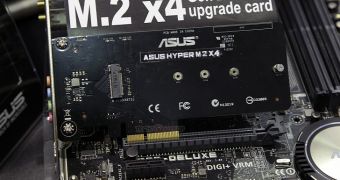The M.2 solid-state drive slot interface looked like a miracle when it came out. For all of two days, before it became apparent that you're not, in fact, likely to have access to that amazing performance. ASUS took exception to that though.
M.2 is both a new interface for solid-state drives, as well as a new form factor for them. M.2 SSDs are about as big as two of your fingers and have the connector on one of the narrow ends.
Almost as soon as the interface was introduced properly, it was revealed that there were two ways to make it work on a motherboard.
The first was to wire it through the SATA interface, essentially making this just a more space-effective type of SATA SSD. The performance topped at 6 Gbps in those cases (500-600 MB/s).
The second way was to wire it through the PCI Express root complex, allowing drives installed in M.2 slots to read and write data at up to 1.8 GB/s. And yes, that's gigabytes, not Gigabits.
Unfortunately, most of the M.2 drives we've seen so far, and the majority of motherboards with support for M.2 as well, use the SATA version.
ASUS must have predicted this, because it has come up with a way around the pesky performance limitation. And it's on the same line as many such solutions: if it doesn't satisfy you, throw a PCI Express card at it and go from there.
And here we are, beholding the ASUS Hyper M.2 X4 adapter, which goes into a PCI Express 2.0/3.0 x4 slot and allows you to add four M.2 SSDs to your PCs. Those SSDs can attain 1.8 GB/s, assuming they're designed for PCI Express tech, not SATA.
Right now, there are only M.2 SSDs with PCI Express 2.0 x2 link layer, but future ones will have PCI Express 2.0 x4, thanks to SandForce 3700 controller chips.
So we suppose that 1.8 GB/s are not, in fact, possible yet. Sequential transfers should still reach and even exceed one GB/s though. And it's not just the M.2 ports that the card brings with it, but some activity LEDs.
Unfortunately, if you're using an older motherboard, the sort that doesn't support M.2 natively, you might need a BIOS update or an F6 driver from the maker of your SSD. Or both. Hopefully, the PCI Express board will be sold in a bundle with solid-state drives, which will be good incentive for such drivers to be developed. Then again, that might not necessarily happen.

 14 DAY TRIAL //
14 DAY TRIAL //